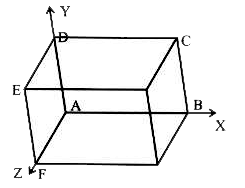A loop made of straight edegs has six corners at A(0,0,0),B(L,O,0)C(L,L,0),D(0,L,0)E(0,L,L) and F(0,0,L). Where L is in meter. A magnetic field B=B0(ˆi+ˆk)T is present in the region. The flux passing through the loop ABCDEFA (in that order) is
The correct Answer is:200
To find the magnetic flux passing through the loop ABCDEFA in the given magnetic field, we can follow these steps:
Step 1: Identify the Points
The corners of the loop are given as:
- A(0,0,0)
- B(L,0,0)
- C(L,L,0)
- D(0,L,0)
- E(0,L,L)
- F(0,0,L)
Step 2: Determine the Magnetic Field
The magnetic field is given by:
B=B0(^i+^k)T
Step 3: Identify the Planes of the Loop
The loop consists of two main planes:
1. The base plane ABCD lies in the xy-plane (where z=0).
2. The vertical plane ADEF lies along the xz-plane.
Step 4: Calculate the Area Vectors
- For the base plane ABCD:
- The area vector AABCD is perpendicular to the plane and directed along the z-axis:
AABCD=L2^k
- For the vertical plane ADEF:
- The area vector AADEF is perpendicular to the plane and directed along the x-axis:
AADEF=L2^i
Step 5: Combine the Area Vectors
The total area vector A for the loop can be expressed as:
A=AABCD+AADEF=L2^k+L2^i
Step 6: Calculate the Magnetic Flux
The magnetic flux Φ through the loop is given by the dot product of the magnetic field B and the area vector A:
Φ=B⋅A
Substituting the values:
Φ=B0(^i+^k)⋅(L2^i+L2^k)
Step 7: Compute the Dot Product
Calculating the dot product:
Φ=B0(L2(^i⋅^i)+L2(^k⋅^k))=B0(L2(1)+L2(1))=B0(2L2)
Step 8: Final Result
Thus, the magnetic flux passing through the loop ABCDEFA is:
Φ=2B0L2Weber
The corners of the loop are given as:
- A(0,0,0)
- B(L,0,0)
- C(L,L,0)
- D(0,L,0)
- E(0,L,L)
- F(0,0,L)
The magnetic field is given by:
B=B0(^i+^k)T
The loop consists of two main planes:
1. The base plane ABCD lies in the xy-plane (where z=0).
2. The vertical plane ADEF lies along the xz-plane.
- For the base plane ABCD:
- The area vector AABCD is perpendicular to the plane and directed along the z-axis:
AABCD=L2^k
- The area vector AADEF is perpendicular to the plane and directed along the x-axis:
AADEF=L2^i
The total area vector A for the loop can be expressed as:
A=AABCD+AADEF=L2^k+L2^i
The magnetic flux Φ through the loop is given by the dot product of the magnetic field B and the area vector A:
Φ=B⋅A
Substituting the values:
Φ=B0(^i+^k)⋅(L2^i+L2^k)
Calculating the dot product:
Φ=B0(L2(^i⋅^i)+L2(^k⋅^k))=B0(L2(1)+L2(1))=B0(2L2)
Thus, the magnetic flux passing through the loop ABCDEFA is:
Φ=2B0L2Weber
Topper's Solved these Questions
- JEE MAIN REVISION TEST- 24 Book:VMC MODULES ENGLISHChapter:JEE MAIN REVISION TEST- 24 Exercise:PHYSICS ( SECTION - 2)
Explore 5 Videos
- JEE MAIN REVISION TEST- 16Book:VMC MODULES ENGLISHChapter:JEE MAIN REVISION TEST- 16Exercise:PHYSICS (SECTION 2)
Explore 5 Videos
- JEE Main Revision Test-20 | JEE-2020 Book:VMC MODULES ENGLISHChapter:JEE Main Revision Test-20 | JEE-2020 Exercise:PHYSICS
Explore 25 Videos
Similar Questions
A loop A(0,0,0)B(5,0,0)C(5,5,0)D(0,5,0)E(0,5,10) and F(0,0,10) of straight edges has six corner points and two sides. The magnetic field in this region is →B=(3ˆi+4ˆk) T. The quantity of flux through the loop ABCDEFA (in Wb) is

View SolutionA loop A(0,0,0)B(5,0,0)C(5,5,0)D(0,5,0)E(0,5,10) and F(0,0,10) of straight edges has six corner points and two sides. The magnetic field in this region is →B=(3ˆi+4ˆk) T. The quantity of flux through the loop ABCDEFA (in Wb) is

View SolutionL1=L0+rt. What does L(0) represent in the given expression?
View SolutionConsider a loop ABCDEFA. With coordinates A (0, 0, 0), B(5, 0, 0), C(5, 5, 0), D(0, 5, 0) E(0, 5, 5) and F(0, 0, 5). Find magnetic flux through loop due to magnetic field →B=3ˆi+4ˆk
View SolutionConsider a loop ABCDEFA. With coordinates A (0, 0, 0), B(5, 0, 0), C(5, 5, 0), D(0, 5, 0) E(0, 5, 5) and F(0, 0, 5). Find magnetic flux through loop due to magnetic field →B=3ˆi+4ˆk
View SolutionA loop ABCA of straight edges has three corner points A (8, 0, 0), B (0, 8, 0 ) and C (0, 0, 8). The magnetic field in this region is →B=5(ˆi+ˆj+ˆk)T0 . The quantity of flux through the loop ABCA (in Wb) is _____.
View SolutionA loop ABCA of straight edges has three corner points A (8, 0, 0), B (0, 8, 0 ) and C (0, 0, 8). The magnetic field in this region is →B=5(ˆi+ˆj+ˆk)T0 . The quantity of flux through the loop ABCA (in Wb) is _____.
View SolutionA square shaped, conducting wire loop of side L, total mass m and total resistance R initially lies in the horizontal x−y plane, with corners at (x,y,z)=(0,0,0),(0,L,0),(L,0,0),and(L,L,0). There is a uniform upward magnetic field in the space within and around the loop. The side of the loop that extends from (0,0,0)→(L,0,0) is held in place on the x-axis, the rest of the loop is released, it begins to rotate due to the gravitational torque.
(a) Find the net torque (magnitude and direction)that acts on the loop when it has rotated through an anglr ϕ from its original orientation and is rotating dounward at an angular speed ω.
(b) Find the angular acceleration of the loop at the instant described in part (a).
( c) Compared to teh case with zero magnetic field, does it take the loop a longer or shorter time to rotate through 90∘ ? Explain.
(d) Is mechanical energy conserved as the loop rotates downward ? Explain.
View SolutionA conductor AB of length l moves in xy plane with velocity →v=v0(ˆi−ˆj). A magnetic field →B=B0(ˆi+ˆj) exists in the region. The induced emf is
View SolutionA square of side L meters lies in the xy-plane in a region, where the magnetic field is given by =B0(2ˆi+3ˆj+4ˆk)T,, where B0 is constant. The magnitude of flux passing through the square is
View Solution
